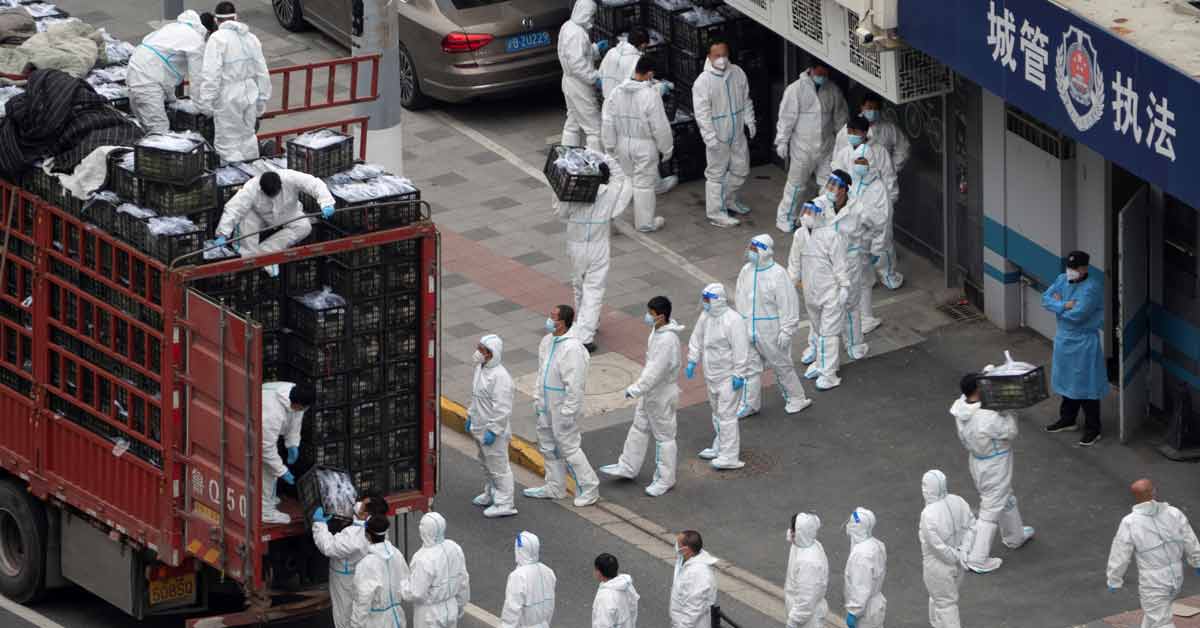It's the first time Shanghai has imposed such strict restrictions – until last month, it had taken a more relaxed approach than other Chinese cities.
What's Happening In Shanghai?
People in the city are confined to their homes, and most have to order in food and water and wait for government drop-offs of vegetables, meat and eggs.
Videos shared on social media show complaints by angry residents about food shortages and inadequate medical supplies.
It's Shanghai's first experience of a city-wide lockdown. Up till last month, it had tackled growing infection rates through smaller localised lockdowns.
This typically meant individual residential complexes, each housing several hundred people, were locked down – instead of the entire city. And for a while, it looked like this method was working. Even when case numbers rose to nearly 1,800 in March 2021, Shanghai did not impose a full lockdown.
By comparison, Xi'an, which is home to nearly 13 million people, sealed the entire city after less than 100 cases in December 2021.
The city of Yuzhou, in Henan province, locked over 1.1 million people at home due to just three COVID cases. But in late March, Shanghai began seeing huge numbers – with more than 2,500 cases recorded on 27 March alone.
The city decided to announce a phased lockdown, firstly in its eastern district, and then its western district days later. But as cases continued growing, Shanghai officials abandoned the idea of keeping half the city open. A city-wide lockdown followed on 3 April.
Prof Martin Hibberd at the London School of Hygiene and Tropical Medicine thinks that Shanghai's previous approach was not suited to the Omicron variant, which is far more transmissible.
"Localised lockdowns of complexes are unlikely to restrict social interactions sufficiently, with such a large amount of asymptomatic transmission," he says. Why has Shanghai differed from the rest of China until now?
The main reason is its importance for the Chinese economy.
Shanghai has contributed over three percent of China's gross domestic product (GDP) and makes up over 10 percent of China's total trade since 2018.
Airports in Shanghai have also been responsible for bringing in nearly half of the protective equipment and medicine that China needed in the early days of the pandemic, according to local news outlet Caixin.
In 2020, cargo flights into Shanghai Pudong International Airport accounted for 3.4 million tonnes of goods – a million more than the airports in the cities of Beijing, Guangzhou and Shenzhen combined.
Studies from the Chinese University of Hong Kong show a two-week lockdown on megacities like Beijing or Shanghai could cost China two percent of its monthly GDP.
China's monthly GDP in 2021 was 9.5 trillion yuan (US$1.4 trillion) on average, so the country would stand to lose about 190 billion yuan (US$29.8 billion) for each week the lockdown continues. Are these measures enough to tackle Omicron?
Prof Hibberd suggests that these tough measures in Shanghai still may not be enough to tackle the outbreak of a highly transmissible variant like Omicron.
Instead, he says, the highest priority to mitigate the effects of COVID should be to encourage everybody, "especially vulnerable people, to get vaccinated".
China has given more than 11 billion doses of COVID vaccines and vaccinated over 86 percent of its entire population.
But vaccine rates among people over the age of 80 – who are among the most vulnerable – remain a lot lower than other age groups. The Chinese National Health Commission now says that vaccinating elderly people should be the priority task for local authorities. It has also approved clinical trials of two COVID-19 vaccines that use mRNA.
Until now, the country has heavily relied on domestically produced vaccines which have been found to be inadequate for use with the Omicron variant.
The Health Commission has stated that "the current vaccines are still effective in tackling Omicron" but did not specify whether it was including Chinese vaccines in this.
When Will The Lockdown Be Eased?
Shanghai has now relaxed some restrictions by dividing the city into three zones – lockdown zone, controlled zone and precautionary zone.
Areas which have no new cases in a week will be marked as "control", and if they reach two weeks with no new cases, they will be further downgraded to "prevention".
People in the zones with fewer or no cases will have more freedom, such as being allowed to move around within their housing compounds.
